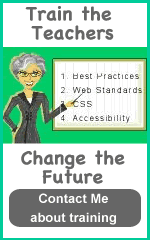Don’t be scared off by the legal looking stuff in the top screen or two of Jim Thatcher’s expert declaration. This is fascinating reading, even though it is a legal document. Once you get into the actual declaration it’s easy reading, too.
Thatcher tells about his background and why he’s qualified as an expert in this case. Then he explains point by point why the target.com site fails to be accessible to a blind user. The site fails on many points that are easily fixed.
Any instructor teaching a class that explained best practices for accesssibility would explain to students how to avoid these failures as core knowledge for the course. To me, it ties in with my question from a couple of days ago: What’s the problem? Why didn’t Target find web builders who regarded accessibility features such as alt text and form labels as intrinsic to any design? A company shouldn’t have to be taken to court to be forced to provide such commonly acknowledged accessibility features. What’s the problem when a major retailer puts up a huge profit-making site intended for millions of shoppers and doesn’t develop the site using basic accessiblity standards? What bit of information is missing from the corporate decision maker’s site-launch-equation that would prevent such blatant mistakes from being made in the first place?
Technorati Tags: web design, accessibility, usability, education, web design education, web standards
